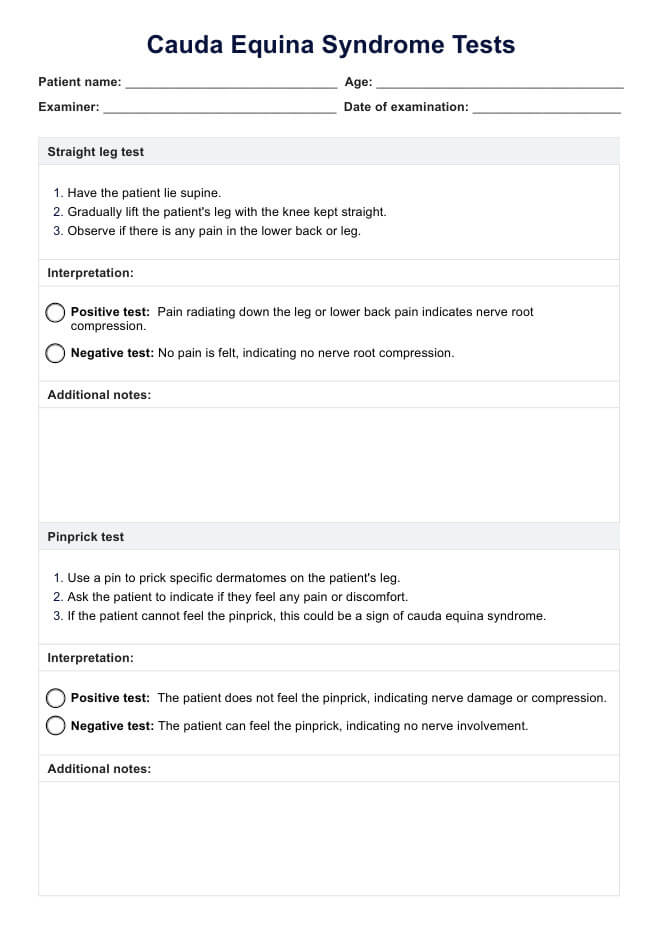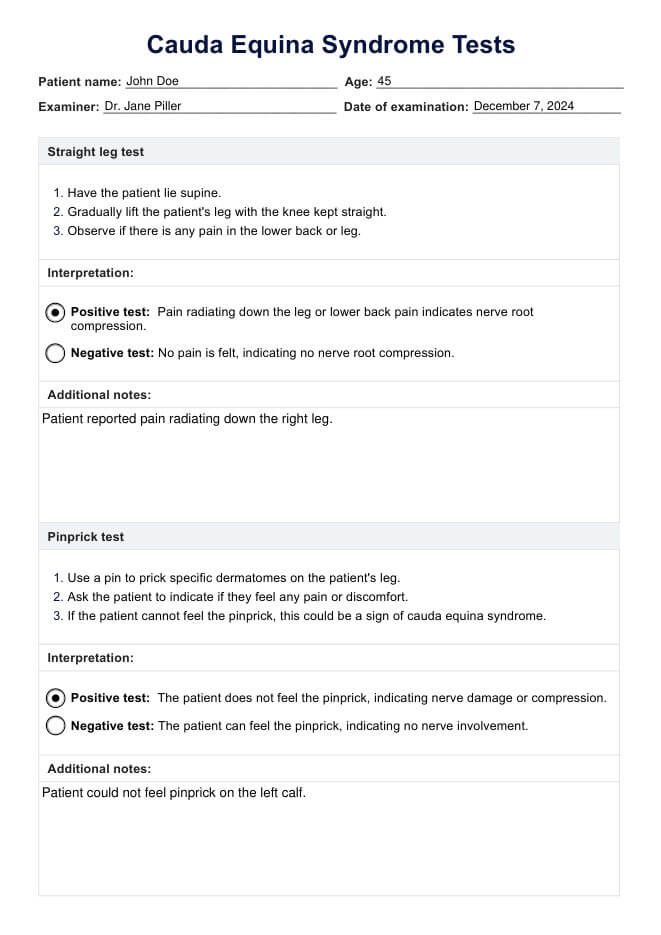Cauda Equina Syndrome Tests
Learn about the various tests to diagnose Cauda Equina Syndrome, including symptoms, diagnostic methods, and treatment guidelines. Download our free template.


What is cauda equina syndrome?
Cauda equina syndrome (CES) is a serious medical condition where the bundle of nerves at the lower end of the spinal cord (the cauda equina) is compressed. This can lead to severe lower back pain, bladder dysfunction, bowel incontinence, muscle weakness or sensory loss in the legs, and even paralysis.
Risk factors include spinal trauma, herniated discs, and tumors. Symptoms such as persistent pain, fatigue, dizziness, and shortness of breath often vary in intensity but usually worsen over time, necessitating urgent medical attention.
Cauda Equina Syndrome Tests Template
Cauda Equina Syndrome Tests Sample
How to diagnose and test for cauda equina syndrome
Diagnosing CES requires a clinical evaluation and imaging tests. Here’s the typical path healthcare professionals follow when addressing suspected cauda equina syndrome:
Initial assessment
- Patient history: Start by collecting a thorough patient history. Ask about specific symptoms, such as bladder or bowel incontinence, which can indicate severe nerve compression. Also, inquire about severe back pain and any leg weakness or numbness. Understanding the onset and progression of these symptoms is crucial for an accurate diagnosis and emotional support.
- Physical examination: Perform a detailed physical examination - beyond the cauda equina nerves. This includes doing various tests like the straight leg test, pinprick test, bulbocavernosus reflex (BCR) test, catheter tug test, ankle reflex test and a rectal examination.
Imaging tests
- Magnetic resonance imaging (MRI): An MRI scan is the most accurate CES test for visualizing nerve compression. It provides detailed images of the spinal cord, nerve root, and surrounding tissues, helping pinpoint the compression's exact location and severity.
- CT myelography: This test is used if an MRI is unavailable or contraindicated. It involves injecting a contrast dye into the spinal canal followed by a CT scan, allowing for detailed imaging of the spinal cord and nerve roots.
- Lumbar spine X-rays: Although less detailed than MRI and CT Myelography, lumbar spine X-rays can help rule out other conditions, such as fractures, tumors, or severe degenerative changes that might mimic CES symptoms when left untreated.
Neurological tests
- Bladder and bowel function tests: These tests are essential for measuring urinary retention and bowel dysfunction, both critical indicators of CES. They can include urodynamic studies and rectal examinations to assess nerve function related to bladder and bowel control.
- Electromyography (EMG) and nerve conduction studies (NCS): EMG measures the electrical activity in muscles, while NCS assesses the speed and strength of signals traveling in the nerves. These tests can help determine the extent of nerve damage and differentiate CES from other neurological conditions.
Download our template for a structured approach to diagnosing cauda equina syndrome. This resource provides detailed checklists and guidelines to ensure that critical steps are completed.
Benefits of using our template
Using our template brings numerous advantages to your diagnostic process:
- Streamlined diagnosis: Our step-by-step guidelines make the diagnostic process simpler and more organized, reducing the chance of missing critical steps.
- Time efficiency: Save valuable time with a ready-made template that allows for quick and efficient assessments, allowing you to focus more on patient care.
- Comprehensive coverage: Our template encompasses everything from basic physical examinations to advanced imaging techniques, ensuring no aspect of diagnosis is overlooked.
Incorporating our template into your practice will give you many more advantages. It provides a structured approach that is simple to follow, covering critical aspects such as bladder or bowel function, sacral spinal cord health, and bowel control. Facilitating better monitoring through tests that help assess conditions like spinal injury, herniated disk, and potential permanent paralysis.
Commonly asked questions
The cauda equina nerve roots control motor and sensory functions in the lower extremities, as well as the function of pelvic organs such as the bladder and bowel.
Cauda equina compression can be caused by herniated discs, spinal stenosis, tumors, infections, or traumatic injuries that exert pressure on the cauda equina nerve roots.
Cauda equina syndrome can lead to bladder dysfunction, resulting in urinary retention or incontinence due to the loss of communication between the nerves and the bladder muscles.
Bowel dysfunction in cauda equina syndrome can manifest as incontinence or severe constipation, as the nerve impairment disrupts normal bowel control.
Motor function in the lower extremities is often compromised, leading to muscle weakness, difficulty walking, and in severe cases, paralysis.

.jpg)





































































































